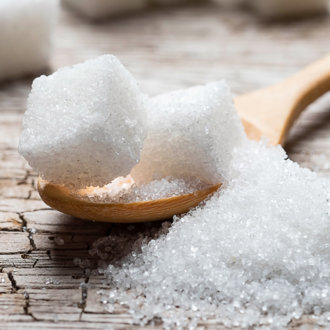Facts on Sugar
What are sugars?
The simplest types of sugars are fructose, glucose and galactose.
Glucose + Fructose = sucrose (table sugar)
Glucose + Galactose = Lactose (milk sugar)
Glucose + Glucose = Maltose
Thousands of Glucose molecules attached = starch
Digestion: Both Sugars and Starches are carbohydrates which are digested by enzymes resulting in a mixture of monosaccharides; glucose, fructose and galactose. These simple sugars are then absorbed and sent to the liver via the portal vein.
Various factors affect sugar digestion and absorption. For example, if sugars or starches are consumed with foods containing fibre, it can interfere in gastric emptying (the speed at which food leaves the stomach) which will slow the time it takes for the monosaccharides to appear in the blood stream. Protein and fat also slow digestion.
Once the sugars are in the liver, the liver directs them to their respective metabolic pathway. Glucose is the primary fuel source and is used by all tissues in the body for energy production (ATP). Red blood cells rely solely on glucose for fuel.
When blood glucose levels are low, glucose is restocked through the breakdown of carbohydrates when we eat, released from glucose stores (glycogen) from the muscles and liver, or produced from other sources of energy such as fructose, galactose and proteins (if we have not eaten for a while).
Carbohydrates (sugars and starches) provide 4 calories per gram and fibre provides 2 calories per gram.
What is the difference between naturally occurring and added sugars?
Sugar is pure sucrose which is produced through photosynthesis and is in all fruits and vegetables, along with fructose and glucose. Table sugar is derived from sugar cane or sugar beets. The body uses sucrose from sugar cane the same way it uses sucrose from fruits and vegetables. Both are broken down into glucose and fructose to be used in the body. Both provide 4 calories per gram. The difference is not in the digestion, but in the nutrients the sugar comes with. Fruits and vegetables offer fibre, vitamins, minerals and antioxidants in addition to the sugar. Table sugar is refined and offers only sugar.
Is table sugar different than other sugars?
Brown sugar, honey, maple syrup, agave syrup and high fructose corn syrup are other sources of sugars that also provide 4 calories per gram. All of them are composed of glucose, fructose and varying amounts of sucrose. All of them provide an insignificant amount of vitamins and minerals.
Why are sugars added to foods? Beyond flavor and sweetness:
Preservation: In jams and jellies, sugar absorbs moisture, reducing available water and thereby reducing bacterial growth potential.
Fermentation: sugar is the fuel for yeast in fermented foods. The gas produced from yeast fermentation makes bread rise.
Browning (caramelization and Maillard reaction): When sugar is exposed to heat, the browning reaction adds flavor and colour to bread crusts and cookies.
Tenderization: Sugar is used to keep baked goods moist and can delay staleness. (softens gluten networks)
Crystallization control: leading to the creation of taffy vs hard candy
Boiling point increase: Sugar increases the boiling point of solutions
Freezing point depression: sugar reduces the freezing point and provides scoopabiity to frozen desserts such as ice cream.
Texture: Sugar provides viscosity or syrupy textures in sauces
Sugar provides bulk which impacts mouthfeel and texture (smoothness of ice cream)
Sugar stabilizes egg whites when whipped together to keep angel food cake light and fluffy.
Flavour: Sugar enhances flavor, releases aromas, and balances the bitterness of cocoa, the sourness of yogurt and the acidity of tomatoes.
What happens when foods are made without sugar?
Due to the many functions of sugar in food, the reduction or removal of sugar is not as simple as replacing it with another ingredient or cutting it out. The goal of reformulation would be to improve the nutritional profile of the food, however, when replacing sugar, it often requires more than one ingredient, some of which are additives. In other cases, sugars are removed but starches are added, and the resulting glycemic index may be higher, and the product may have the same calories as before.
In the case of ice cream, sugar provides sweetness, creamy texture, bulk and a depression of the freezing point to make it scoopable. When sugar is removed from ice cream, often artificial sweeteners are used for sweetness, but they don’t help with the freezing point so then glycerol needs to be added. Or sugar alcohols are used but they don’t add bulk so then maltodextrins are added. In the end the calorie content often comes out the same, the GI increases and the ingredient list grows.
The Bottom Line:
In most foods, sugar contributes many functional properties beyond sweetness. Replacement of sugar, one-to-one with another ingredient is not possible. Ideally the replacement of sugar should have the goal of improved nutritional profile and deliver a product of lower calorie, GI and clean ingredient list. If it can’t do that, the better option is to eat smaller portions of the sugar containing food and to remember the 80-20 Rule. Aim to eat 80% healthy foods and 20% not so healthy foods.















